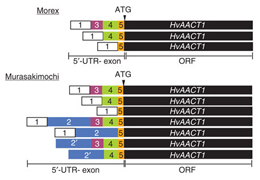Research Abstract
大麦は1遺伝子の変化によりアルミニウム耐性を獲得した
Acquisition of tolerance by modification of a single gene in barley
2012年3月6日 Nature Communications 3 : 713 doi: 10.1038/ncomms1726

大麦は中東の肥沃な三角地帯を起源とし、栽培域の拡大によって現在では、酸性土壌を含む性質の異なる土壌でも栽培されている。酸性土壌では、アルミニウム毒性が主な制限要因の1つとなる。本論文では、この大麦の酸性土壌への適応力がクエン酸輸送体をコードする1遺伝子(HvAACT1)の変化により獲得されたことを明らかにする。我々は、このタンパク質の本来の役割は、根の内鞘細胞から導管にクエン酸を放出することによる、根から地上部への鉄輸送の促進であることを見いだした。一方で、アルミニウム耐性の系統だけに見られるHvAACT1コード領域上流への約1000塩基対(1 kb)の挿入により、その発現量が増え、発現部位も根端へと拡大した。この変化したHvAACT1が、根圏へのクエン酸の分泌によるアルミニウムの無毒化に重要な役割を獲得した。このように、HvAACT1上流への1 kbの塩基配列の挿入が、大麦の酸性土壌への適応を可能にした。
- 岡山大学 資源植物科学研究所
- 名古屋大学 生命農学研究科
Originating from the Fertile Crescent in the Middle East, barley has now been cultivated widely on different soil types including acid soils, where aluminium toxicity is a major limiting factor. Here we show that the adaptation of barley to acid soils is achieved by the modification of a single gene (HvAACT1) encoding a citrate transporter. We find that the primary function of this protein is to release citrate from the root pericycle cells to the xylem to facilitate the translocation of iron from roots to shoots. However, a 1-kb insertion in the upstream of the HvAACT1 coding region occurring only in the Al-tolerant accessions, enhances its expression and alters the location of expression to the root tips. The altered HvAACT1 has an important role in detoxifying aluminium by secreting citrate to the rhizosphere. Thus, the insertion of a 1-kb sequence in the HvAACT1 upstream enables barley to adapt to acidic soils.

